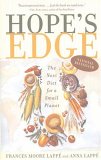Summary | Excerpt | Reviews | Readalikes | Genres & Themes | Author Bio

Critics' Opinion:
Readers' Opinion:
First Published:
Jan 2002, 400 pages
Paperback:
Apr 2003, 400 pages
When I began, buried in books at that U.C. Berkeley agricultural library, I had one question: Why hunger? Since feeding oneself and one's offspring is the first concern of all living creatures-and since the headlines about hunger and starvation were blaring out to me that humans were failing at this primal task-I thought, What else matters? People have often asked me, "How did you get interested in hunger?" but I've never understood the question. To me all other concerns paled before this central one.
I was 26, and for the first time I became aware that fear served me well. The fear of never discovering whether my path made sense forced me out of a predictable graduate-school-to-career path. It forced me into thin air.
Mustering the strength and using my beginner's mind, my following-my-nose, question-after-question research, I unearthed a fact that changed my life forever: The world produces more than enough to feed us all, while millions go without the food their bodies need to survive. This shocking truth awakened me to other aspects of invisible waste. Most have only gotten worse since:
Such measures of waste in the midst of hunger rocked me to my core. And soon my question changed. No longer "Why hunger?" but "Why hunger in a world of plenty?"
All around me, as I was researching Diet, authorities were worrying about impending food shortages, about frightening scarcity. And yet, I was learning, they were wrong. For a young woman still deferring to experts, it was a shocking revelation. The more I read, the more I discovered that in fact we are all part of a process that is itself generating scarcity, even destroying the very ground beneath ongoing food security.
Worldwide, topsoil is eroding as much as thirty times faster than it's being created. It's gotten so bad that soil particles eroded from Kenya, for example, are blown as far west as Brazil and Florida. So, in just the last forty years, erosion has made almost one-third of our farmable land unusable for growing food. Water resources are being destroyed just as rapidly, not only through pollution of surface water but also, on every continent, by the rapid depletion of underground water by crop irrigation.
Since I wrote my first book, I've come to see the waste I had discovered in our food system replicated in every aspect of production and consumption. Just imagine: Here in the U.S., only one to six percent of all the stuff that goes into producing things turns up as products we can actually use-in other words, we waste more than 90 percent. We can't blame nature. No, we humans are creating scarcity-exactly what we say we most fear. It was almost too unimaginable to believe.
With that realization came another big one, which hit me over the head again just recently.
I'm sitting quietly in a University of Montana forum entitled "Feeding the Hungry," listening to a professor of political science with a Harvard PhD tell his rapt audience about genetically modified organisms-GMOs. Almost three-quarters of all the GMOs planted worldwide are here in the U.S. Launched with our government's help but after virtually no public debate, genetically modified crops covered less than four million acres of U.S. cropland six years ago. Today, they're planted on 75 million acres, with more than half our soybeans and almost three-fourths of our cotton crops now GMO.9 Walking down our grocery aisles, we can assume that more than half the products we see contain at least a trace of them.





The House on Biscayne Bay
by Chanel Cleeton
As death stalks a gothic mansion in Miami, the lives of two women intertwine as the past and present collide.

The Flower Sisters
by Michelle Collins Anderson
From the new Fannie Flagg of the Ozarks, a richly-woven story of family, forgiveness, and reinvention.

The Funeral Cryer by Wenyan Lu
Debut novelist Wenyan Lu brings us this witty yet profound story about one woman's midlife reawakening in contemporary rural China.
Your guide toexceptional books
BookBrowse seeks out and recommends the best in contemporary fiction and nonfiction—books that not only engage and entertain but also deepen our understanding of ourselves and the world around us.